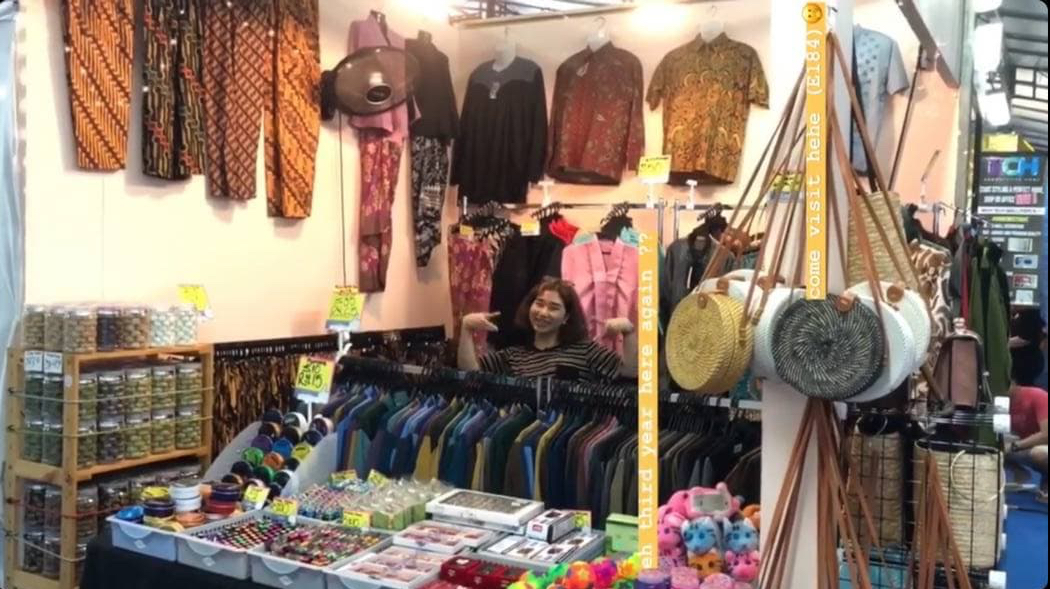Dear Ramadan bazaar…
The Ramadan bazaar has been cancelled once again due to the pandemic. In light of this, Shajahan Mohd heads to the streets to learn more about how much the Ramadan bazaar meant to Muslims and Singaporeans.
The annual Ramadan bazaar in 2019, before the COVID-19 pandemic occurred. Photo courtesy of Nur Khalidah Bte Kamsani
BY
Shajahan Mohd
Editorial admin
HYPE issue #53
Published on
May 14, 2021
I was always excited to visit the yearly Ramadan/Geylang bazaar.
The colourful sparkly lights, the smell of kebabs slow-cooking, the loud traditional Malay music playing, the busy crowds and the commotion are all things I miss about Ramadan.
With the bazaar gone for two years in a row, due to pandemic, I certainly miss it now more than ever.
For our overseas readers, the Ramadan bazaar is a market in Singapore for vendors to sell all things festive. Baju Kurungs (traditional Malay attire), traditional sweets and delicacies are just some of the products sold there to celebrate the month of Ramadan.
The month of Ramadan is an important time period for Muslims to fast and engage in acts of worship.
Singapore has been holding the month-long bazaar every year at Geylang Serai, where the Malay and Muslim communities used to live.
Since the 1980s, the bazaar has been a way for Muslims to prepare for Hari Raya, also known as the day of celebration when the fasting month ends.
‘Di waktu petang di Geylang Serai’ is a song composed by Ahmad Jafaar, which means Geylang Serai in the evening.
It paints a picture of how Geylang Serai was a haven for people to find all things fashion and for hawkers to sell their products in the evenings of the Ramadan Month.
Despite the crowd and the heat, the bazaar has always been associated with a sense of belonging, traditionality and festivity for Muslims.
Although efforts like the Bazaar Kita initiative have been made to shift the bazaar online due to the pandemic, many feel like it’s just not the same as having the yearly colourful and beautiful traditional Ramadan bazaar.
“Everyone we meet are not people we know, but the environment makes it look like it’s one big family. It’s different now. Nowadays, even neighbours are strangers, like you’ve never met them before,” says Ms Zeenatunnisa D/O Mohd Haniffa, 55, recalling how special the Ramadan bazaar was to her back then.
The bazaar, together with the community spirit, has definitely evolved to become something more modern over the years. However, not many are in favour of it.
“In those days it was the traditional ketupat, satay and stuff like that and it used to be very, very cheap. And now, with hipster food, you get one big bucket of drinks for $10. Those days, you feed a big family for $10,” says Ms Zeenatunnisa as she points out how the Ramadan bazaar may be losing its traditionality and culture.
Although the bazaar is predominantly for the Muslim community, people of other races also identify it as a part of Singapore’s identity and would participate in it with them. It is not an uncommon sight to see a non-Muslim walking in the bazaar.
“Back then, as well the Gotong Royong, the kampong spirit, was very…strong. So you find that whenever there was any occasion to celebrate, everybody would come together to do that,” says Ms Narendar Kaur, 60.
Gotong Royong is a phrase originating from Indonesia meaning “cooperation in a community” and it’s used to describe the selfless support between residents living in the same community to achieve a collective goal.
Although she believes that the old Geylang bazaar is more traditional, she understands the need for it to evolve.
“Everything [has] got to modernise, you go with the times,” Ms Kaur says, as she explains how the food and clothes have changed to be more current.
The evolution of the bazaar has allowed youths to also have a strong connection with it, be it as a customer or a vendor.
Ms Shannen Coelho, 21, was a vendor at the bazaar from 2017 to 2019. She had helped run a store selling Kueh Raya (traditional delicacies), Baju Raya (traditional Malay attire) and other traditional attires.

Ms Shannen manning her uncle’s store at the Ramadan bazaar in 2019, selling traditional Malay attire. Photo courtesy of Ms Shannen Coelho
“Making friends with the [people at the] store beside you, they help you out when you need them to look out for the store,” she says as she recalled how she viewed adjacent shops as friends rather than rivals.
Unlike other youths, however, Ms Shannen was not happy with the evolution of the bazaar.
“I think all the Instagram-worthy food is not worth it,” she expresses how most of the stores are just selling food that can be made easily but presented nicely and at a high price.
However, it is quite evident that the modernisation of the bazaar has encouraged more youths to visit the bazaar, thereby keeping the tradition alive.
Muhammad Irfaan Bin Abdul Rahaman, 19, believes that a balance of the hipster and traditional culture at Geylang bazaar would be helpful in preserving the culture while meeting the demands of youths and the older generation.
Hipster or not, the absence of the bazaar has made many Muslims and Singaporeans realise how important the bazaar is in the celebration of Hari Raya and Singapore’s identity.
“Having all these many memories at the Geylang bazaar, not having it anymore has made me realise that I didn’t appreciate it enough,” says Irfaan.

Can you be more specific about the content of your article? After reading it, I still have some doubts. Hope you can help me. https://accounts.binance.com/id/register-person?ref=53551167
Thanks for sharing. I read many of your blog posts, cool, your blog is very good. https://accounts.binance.com/vi/register-person?ref=JHQQKNKN
Thank you very much for sharing, I learned a lot from your article. Very cool. Thanks. nimabi
relax
relaxation music
winter jazz
Thanks for sharing. I read many of your blog posts, cool, your blog is very good.
… [Trackback]
[…] Read More Info here to that Topic: hypesingapore.com/index.php/2021/05/16/dear-ramadan-bazaar-2/ […]
… [Trackback]
[…] Find More on that Topic: hypesingapore.com/index.php/2021/05/16/dear-ramadan-bazaar-2/ […]
… [Trackback]
[…] Read More Info here to that Topic: hypesingapore.com/index.php/2021/05/16/dear-ramadan-bazaar-2/ […]
… [Trackback]
[…] Read More Info here on that Topic: hypesingapore.com/index.php/2021/05/16/dear-ramadan-bazaar-2/ […]
… [Trackback]
[…] Here you can find 51616 additional Information on that Topic: hypesingapore.com/index.php/2021/05/16/dear-ramadan-bazaar-2/ […]
… [Trackback]
[…] Find More Info here to that Topic: hypesingapore.com/index.php/2021/05/16/dear-ramadan-bazaar-2/ […]
… [Trackback]
[…] Find More here to that Topic: hypesingapore.com/index.php/2021/05/16/dear-ramadan-bazaar-2/ […]
Your point of view caught my eye and was very interesting. Thanks. I have a question for you.
… [Trackback]
[…] Read More Information here to that Topic: hypesingapore.com/index.php/2021/05/16/dear-ramadan-bazaar-2/ […]
… [Trackback]
[…] Read More on on that Topic: hypesingapore.com/index.php/2021/05/16/dear-ramadan-bazaar-2/ […]
… [Trackback]
[…] Information to that Topic: hypesingapore.com/index.php/2021/05/16/dear-ramadan-bazaar-2/ […]
… [Trackback]
[…] Info on that Topic: hypesingapore.com/index.php/2021/05/16/dear-ramadan-bazaar-2/ […]
… [Trackback]
[…] Info to that Topic: hypesingapore.com/index.php/2021/05/16/dear-ramadan-bazaar-2/ […]
… [Trackback]
[…] Read More Information here on that Topic: hypesingapore.com/index.php/2021/05/16/dear-ramadan-bazaar-2/ […]
… [Trackback]
[…] Info on that Topic: hypesingapore.com/index.php/2021/05/16/dear-ramadan-bazaar-2/ […]
cinemakick .com
Thanks for sharing. I read many of your blog posts, cool, your blog is very good.
… [Trackback]
[…] Read More here to that Topic: hypesingapore.com/index.php/2021/05/16/dear-ramadan-bazaar-2/ […]
recipesjelly
… [Trackback]
[…] Read More Info here on that Topic: hypesingapore.com/index.php/2021/05/16/dear-ramadan-bazaar-2/ […]
… [Trackback]
[…] Read More on that Topic: hypesingapore.com/index.php/2021/05/16/dear-ramadan-bazaar-2/ […]
… [Trackback]
[…] Read More to that Topic: hypesingapore.com/index.php/2021/05/16/dear-ramadan-bazaar-2/ […]
… [Trackback]
[…] Information to that Topic: hypesingapore.com/index.php/2021/05/16/dear-ramadan-bazaar-2/ […]
… [Trackback]
[…] Info on that Topic: hypesingapore.com/index.php/2021/05/16/dear-ramadan-bazaar-2/ […]
… [Trackback]
[…] Here you will find 41127 additional Info to that Topic: hypesingapore.com/index.php/2021/05/16/dear-ramadan-bazaar-2/ […]
… [Trackback]
[…] Read More Information here on that Topic: hypesingapore.com/index.php/2021/05/16/dear-ramadan-bazaar-2/ […]
… [Trackback]
[…] Find More Info here on that Topic: hypesingapore.com/index.php/2021/05/16/dear-ramadan-bazaar-2/ […]
… [Trackback]
[…] Info to that Topic: hypesingapore.com/index.php/2021/05/16/dear-ramadan-bazaar-2/ […]
… [Trackback]
[…] Here you will find 24858 more Info on that Topic: hypesingapore.com/index.php/2021/05/16/dear-ramadan-bazaar-2/ […]
… [Trackback]
[…] Find More on that Topic: hypesingapore.com/index.php/2021/05/16/dear-ramadan-bazaar-2/ […]
… [Trackback]
[…] Find More Information here on that Topic: hypesingapore.com/index.php/2021/05/16/dear-ramadan-bazaar-2/ […]
… [Trackback]
[…] Info on that Topic: hypesingapore.com/index.php/2021/05/16/dear-ramadan-bazaar-2/ […]
… [Trackback]
[…] Read More here to that Topic: hypesingapore.com/index.php/2021/05/16/dear-ramadan-bazaar-2/ […]
… [Trackback]
[…] Information to that Topic: hypesingapore.com/index.php/2021/05/16/dear-ramadan-bazaar-2/ […]
… [Trackback]
[…] Here you can find 14539 additional Info on that Topic: hypesingapore.com/index.php/2021/05/16/dear-ramadan-bazaar-2/ […]
… [Trackback]
[…] Here you will find 70869 more Info on that Topic: hypesingapore.com/index.php/2021/05/16/dear-ramadan-bazaar-2/ […]
… [Trackback]
[…] Read More on to that Topic: hypesingapore.com/index.php/2021/05/16/dear-ramadan-bazaar-2/ […]
… [Trackback]
[…] Info on that Topic: hypesingapore.com/index.php/2021/05/16/dear-ramadan-bazaar-2/ […]